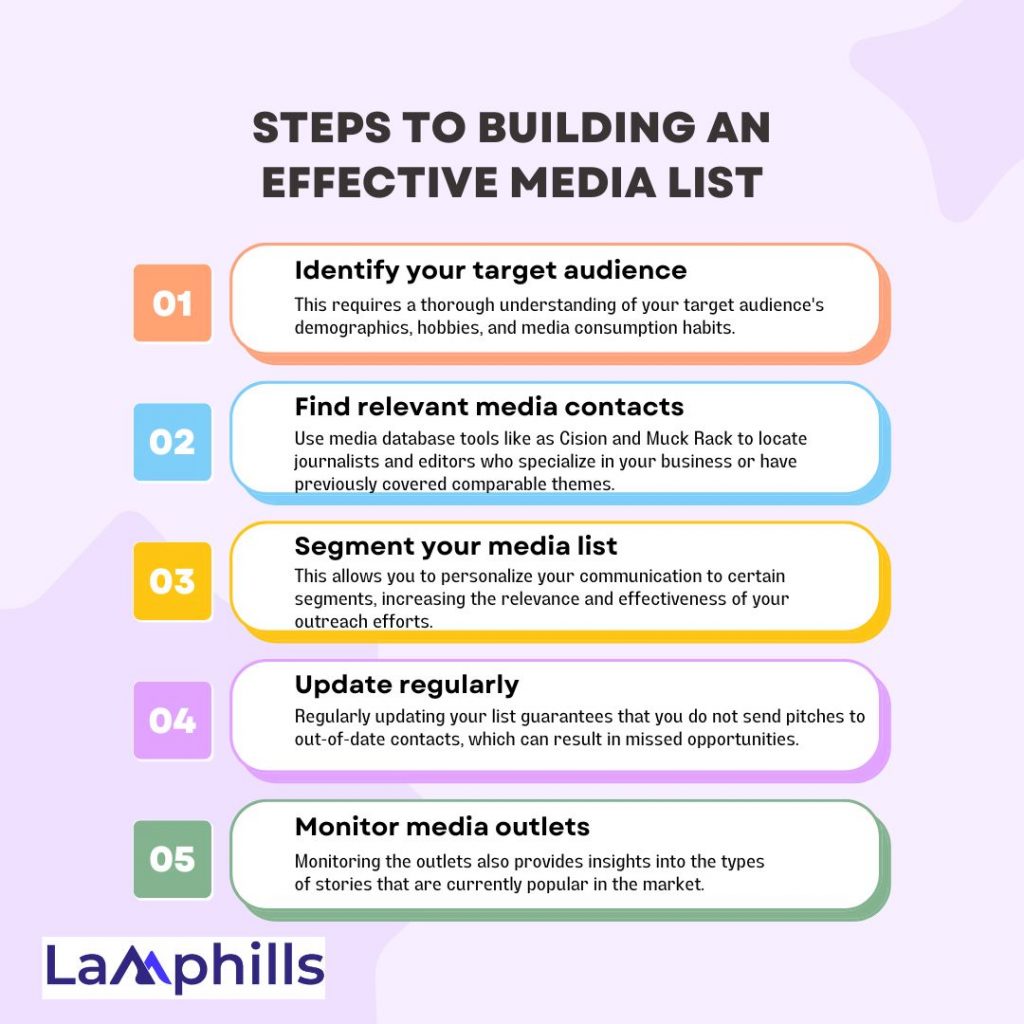A recent Cision survey discovered that journalists receive an average of 50 pitches every day. This figure demonstrates the severe struggle for media attention. Creating a customized media list differentiates those who are heard from those who are lost in the email clutter.
Beyond the basics of collecting names and contact information, there is a lesser-known secret to creating effective media lists: recognizing the journalist’s specialization. Let’s go deeper and look at the art of creating media lists that resonate, enhancing your chances of landing media placements, and growing brand awareness.
What is a Media List?
A media list is a document that includes the contact information for journalists, influencers, and media outlets who may be interested in writing about or covering your NGO. These people can help you find new donations and raise awareness about your cause.
The more contact information you can include on your media list, the better it will serve your needs. Make sure that each person on your list includes an email address, phone number, type of reporter, employer, and so on.
With a relevant media list, you’ll always be aware of your essential contacts and who to send your clients’ press releases to. Creating a well-researched press list is essential for any communications strategy. It is the foundation of your public relations campaigns.
Key Takeaways
- A media list is a crucial tool for public relations, containing detailed contact information for journalists and media outlets relevant to your organization’s news and events.
- Effective media lists are tailored to specific audiences and segmented by factors like media type, geographic location, or coverage focus, enhancing the precision of PR campaigns.
- Regular updates to a media list are essential due to the dynamic nature of media professions, ensuring all contact information and journalist roles are current.
- Personal relationships with media contacts enhance the effectiveness of pitches, necessitating personalized interactions and knowledge of each journalist’s preferences and interests.
What Does a Media List Contain?
Regardless of the industry, your media listings should include:
- Contact’s first and last names
- Their business or professional role.
- The name of the publication or news outlet
- A link to their website or social media accounts
- Their beat, specialty, and niche
- Their contact details
Also, take notes on their previous works, career history, or any other pertinent details.
What Constitutes an Effective Media List?
The end purpose of a media list is simple: To increase your pitch-to-press conversion.
To accomplish this, create specialized, tailored media lists depending on your coverage goals. Building a media list of general assignment reporters is ineffective when pitching a niche topic.
A good media list should also include pitch preferences and personal annotations. For example, a contact may inform you that they want pitches by 8 a.m. so that they may be ready for their team brainstorm at 9 a.m. Personal notes also help you to strengthen your ties with your contacts, such as following up with them during maternity leave. Public relations professionals might identify pitch preferences in journalist profiles on Muck Rack.
Now, if you do a little research on the internet, you will discover opportunities to buy media lists online. Purchasing media lists may appear to be the simplest option at first glance—you will save a significant amount of time. However, there are several disadvantages.
You cannot rely on pre-made media lists for quality. The information could be obsolete, partial, or simply incorrect. You also risk damaging your reputation by describing yourself and your brand as spammy. Finally, it’s worth mentioning that the email addresses could have been unlawfully obtained, exposing you to sanctions.
Overall, purchasing a media list is not recommended. For best results, create your own media list. This allows you to customize and organize the list by beat, topic, and content type.
Example of a Media List
Here’s an example media list of contacts from Miami in Google Sheets.
Editor’s note: Email addresses and phone numbers have been suppressed for privacy reasons, as these are genuine media contacts from Prowly’s Media Database.
Looking for a media list template? Get the above media contact list as a Google Sheets template that you can fill out yourself. To change, make a duplicate of the template in Google Sheets.
Get the media list template.
Steps To Building an Effective Media List

Creating a strong media list is an important duty for every PR practitioner. Here’s a more in-depth look at how to build a media list that will genuinely boost your outreach efforts:
#1. Identify your target audience
Before you can properly pitch your tales, you need to understand who is most likely to be interested in them. This requires a thorough understanding of your target audience’s demographics, hobbies, and media consumption habits.
Use audience analytics tools and market research to learn about your target demographic’s interests and activities. This information aids in selecting media channels that your target audience trusts and engages with, ensuring that your messages reach the intended eyes and ears.
#2. Find relevant media contacts
Use media database tools like as Cision and Muck Rack to locate journalists and editors who specialize in your business or have previously covered comparable themes. These tools give users access to a multitude of information, including current publications, social media activity, and contact information.
Begin to view your interactions with these connections as the start of a long-term relationship. Read their work, interact with them on social media, and learn about their interests to customize your pitches effectively.
#3. Segment your media list
Organize your contacts by media type (print, broadcast, digital), geographic region, or the nature of their coverage (technology, fashion, business). This allows you to personalize your communication to certain segments, increasing the relevance and effectiveness of your outreach efforts.
By segmenting your list, you can tailor pitches to each journalist or outlet’s specific style and content preferences, increasing your chances of capturing their attention and receiving coverage.
#4. Update regularly
The media industry is recognized for its high turnover rate and frequent job changes. Regularly updating your list guarantees that you do not send pitches to out-of-date contacts, which can result in missed opportunities.
Set aside a regular time, possibly quarterly, to examine and update your media list. This should include confirming contact information, checking journalists’ current roles, and adding new contacts acquired at recent networking events.
#5. Monitor media outlets
Keeping an eye on your targeted media channels allows you to stay up to date on current trends and popular themes. This knowledge enables you to create pitches that are timely and relevant, significantly enhancing your chances of obtaining coverage.
Monitoring the outlets also provides insights into the types of stories that are currently popular in the market. Use this feedback to tailor your strategies and pitches to what is working best.
Why Isn’t My Media List Delivering?
#1. Your information is outdated
Journalists frequently shift outlets, and let’s be honest, it’s difficult to keep track of everything on your radar. Outdated data causes email bouncebacks or ignores (particularly if the names are incorrect). To avoid having obsolete data, try to update your press list regularly.
#2. The media list is rather broad
You send out mass press releases to everyone on your list. Journalists are quick to notice this and avoid opening generic emails. Customize your strategy by employing filters to narrow down your pool of journalist contacts to the relevant names. Consider segmenting your media list by topic, country, etc. Remember that not every press release is worldwide, and approaching journalists from a variety of industries with the same pitch is likely to be perceived as spam.
Keep your press list modest and niche-focused; it will be easy to keep.
#3. There is no relationship with journalists on your list
Personal relationships are vital for both public relations professionals and journalists. When emailing them first, introduce yourself. Make sure you’ve read their articles and examined their social media so you can personalize your approach to their preferences.
Tools For Building Media Lists
When it comes to creating a media list, you are fortunate to have a wide range of tools available on the market.
#1. Finding Media Contacts: Tools and Resources
- LinkedIn (free).
- Twitter (free)
- Prowly (from $293 per month, free 7-day trial)
- Muck Rack (estimated to be roughly $5,000/year)
- JournoLink
- Hey, Press
- PressRush
- Anewstip
#2. Tools for discovering media venues, magazines, and blogs
- Google (free).
- Google News (free)
- Semrush (from $99/month)
- Ahrefs (Free or from $99/month)
#3. Tools for finding email addresses of potential pitch recipients
- Use Similarweb
- Hunter.io
- Anymailfinder
- VoilaNorbert
- Prowly
- Muck Rack
- Anewstip
Now that you understand what a media list is and how to create one, let’s go over some frequently asked questions concerning media lists.
Should You Buy a Media List?
Nonprofits and corporations alike will frequently bypass the laborious task of compiling their own media list by purchasing one that has already been created. The decision to pursue this option will depend on the size of your nonprofit. For major international organizations, it may be easier to buy a list of thousands of media outlets around the world than to create one from scratch. For small NGOs, however, the benefit of developing contacts from the ground up outweighs any time saved by obtaining a media list.
When in doubt, we always advocate creating a media list rather than purchasing one. This technique will assist you in developing personal ties with journalists, influencers, and media outlets. It will also help you keep your list current.
What Information Is Included on a Media List?
In short, the more information you include in your media list, the better. Of course, you’ll want to have contact information for each media outlet (such as a phone number and an email address), but don’t stop there. Here is a list of additional information to include for each contact in your media list.
- Media Type: Does this individual write for a blog or a newspaper? Or are they involved in television? Having this information on hand will allow you to modify your press releases so that they are easily digested by the receiver.
- Topics of interest: Will this person be interested in all of your organization’s activities, or will they be drawn to specific aspects of your program? Do not bother media outlets with stories that they will not be interested in covering.
- Organizational point person: Perhaps one of your board members is friends with someone who works in the media. Make a note of this on their media list item so that your point person can contact them to communicate news.
- Publication schedule: Does this media outlet release news on a daily, weekly, or monthly basis? Also, how long of a lead is required to incorporate a story?
How Do You Start a Conversation With a Media Professional?
When you first start creating a media list, the process can seem daunting. You may be scared by the notion of contacting dozens, if not hundreds, of busy media professionals. If you’re feeling this way, remember that you’re not alone! Creating a media list is a difficult undertaking, but with dedication and patience, you can produce an invaluable record for your nonprofit.
Here are a few recommendations to get you started reaching out to media professionals and building your list.
#1. Use Quora
If you’re not sure where to start with a project, check out Quora. Quora is a digital platform that allows users to ask questions and freely share knowledge. This tool allows you to understand how others have handled conversations with media professionals. Use their experiences to help shape your strategy.
#2. Share relevant content
You remember how we mentioned earlier that you keep a list of themes of interest for all of your media contacts? Here’s where it comes in helpful. One of the finest ways to start a conversation with a media professional is to share relevant content. This entails relying on your study to identify people who will be moved by your cause. This is also where a strong pitch can help you hook and interest someone right away.
Should You Include Social Media Influencers on Your List?
Most individuals now rely on social media as one of their primary sources of nonprofit news. This pattern appears to be sustainable. So, if you’re creating a media list, consider including social media influencers to help you reach more people.
Your community’s demographics will play a role in making this decision. Social media influencers are particularly effective at reaching a younger demographic. If your neighborhood is predominantly older, they may not be as helpful.
Conclusion
Creating a strong media list is only the first step. It is also critical to write appealing pitches that appeal to the journalist’s target audience. Understanding their individual interests allows you to adapt your approach, increasing your chances of receiving media coverage.
Are you ready to revolutionize your media outreach approach and magnify your brand’s voice? When building your media lists, what challenges do you face? Please share your ideas in the comments below!
Lamphills can also help you construct a targeted media list and create appealing media pitches.
Related Articles
- How To Send a Press Release: Your Personal Guide to Making Waves in the Media
- NEWS VALUE: 8 Tips That Will Make Your Content Newsworthy
- Media Training Tactics for Business Success: Elevate Your Communication Skills for Unbeatable Presence
- How Does Having a Social Media Policy Benefit a Business (+Free Policy Template)
- THE ULTIMATE GUIDE TO OWNED MEDIA: Best Strategies & Examples






